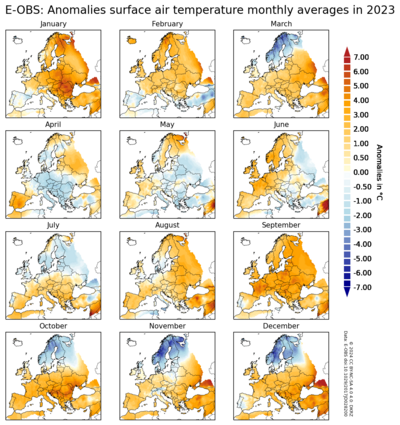Python generate multiple subplots of monthly anomalies#
In this example we want to show i.a. how the data is processed with python-cdo, generate the panel plot using the Transverse Mercator map projection, and at the end save the figure in a PNG file. The daily surface air temperature data of the E-OBS dataset is used, further information on the data set and its download can be found in the script.
Software requirements:
Python 3
matplotlib
cartopy
python-cdo
Example script#
monthly_anomalies.py
#!/usr/bin/env python
# coding: utf-8
'''
DKRZ example
2023 Surface air temperature anomalies of Europe
Description
This Python script demonstrates the data processing with python-cdo
- extract the temperature data for the year 2023
- compute the monthly means
- compute the climatology data from the years 1991-2020
- compute the monthly anomalies for the year 2023
In this example, we use the surface air temperature daily mean variable
tg of the E-OBS dataset. The data extraction and computations in this
notebook are done primarily using the python-CDO package.
------------------------------------------------------------------------------
Data description
From the E-OBS data documentation at CDS:
The E-OBS daily gridded meteorological data for Europe from 1950 to present
derived from in-situ observations.
Gridtype: regular latlon
Resolution: 0.25° x 0.25°
Variables: Mean temperature in °C
We acknowledge the E-OBS dataset and the data providers in the ECA&D project
( https://www.ecad.eu).
Cornes, R., G. van der Schrier, E.J.M. van den Besselaar, and P.D. Jones. 2018:
An Ensemble Version of the E-OBS Temperature and Precipitation Datasets,
J. Geophys. Res. Atmos., 123. doi:10.1029/2017JD028200
Download: https://cds.climate.copernicus.eu/cdsapp#!/dataset/10.24381/cds.151d3ec6?tab=overview
Copernicus Climate Change Service, Climate Data Store, (2020):
E-OBS daily gridded meteorological data for Europe from 1950 to present
derived from in-situ observations.
Copernicus Climate Change Service (C3S) Climate Data Store (CDS).
DOI: 10.24381/cds.151d3ec6 (Accessed on DD-MMM-YYYY)
------------------------------------------------------------------------------
python-CDO:
For the computations in this notebook we use the python-CDO package, the Python
bindings of CDO (Climate Data Operators).
Schulzweida, Uwe. (2023). CDO User Guide (2.3.0). Zenodo.
https://doi.org/10.5281/zenodo.10020800
------------------------------------------------------------------------------
Notes:
- The cartopy map projection Transverse Mercator with a given central_longitude=10.
leads to a strange behavior of the cartopy.features. Use
`ccrs.TransverseMercator(central_longitude=11.,central_latitude=50.) ` instead.
-------------------------------------------------------------------------------
2024 copyright DKRZ licensed under CC BY-NC-SA 4.0
(https://creativecommons.org/licenses/by-nc-sa/4.0/deed.en)
-------------------------------------------------------------------------------
'''
import os
import xarray as xr
import matplotlib.pyplot as plt
import matplotlib.colors as mcolors
import cartopy.crs as ccrs
import cartopy.feature as cfeature
from cdo import Cdo
cdo = Cdo()
def main():
#------------------------------------------------------------------------------
# E-OBS daily data
#
# Open the dataset of the surface air temperature mean data, if it doesn't exist
# merge the single tg files using CDO.
#------------------------------------------------------------------------------
dpath = os.environ['HOME']+'/data/E-OBS/'
files = dpath + 'tg_ens_mean_0.25deg_reg_*.nc'
tg_all = dpath + 'tg_0.25deg_1950-2023.nc' #-- output file name
if not os.path.exists(tg_all):
cdo.mergetime(input=f'{files}', options='-O', output=tg_all)
#------------------------------------------------------------------------------
# Compute monthly means
#
# First, compute the monthly mean data from the daily data.
#------------------------------------------------------------------------------
data_file = dpath + 'tg_2023_monthly_mean.nc'
if not os.path.exists(data_file):
cdo.monmean(input=f'-selyear,2023 {tg_all}',
options='-O --reduce_dim', output=data_file)
#------------------------------------------------------------------------------
# Climatology
#
# Compute the 30-years monthly reference data using the time range 1991-2020.
#------------------------------------------------------------------------------
ref_time = [1991, 2020]
clim_file = dpath + 'tg_clim_1991-2020_monthly_mean.nc'
if not os.path.exists(clim_file):
cdo.ymonmean(input=f'-selyear,{ref_time[0]}/{ref_time[1]} {tg_all}',
options='-O --reduce_dim', output=clim_file)
#------------------------------------------------------------------------------
# Anomalies
#
# Compute the anomalies for the year 2023.
#------------------------------------------------------------------------------
anom_file = dpath + 'tg_2023_anomaly_monthly_mean.nc'
if not os.path.exists(anom_file):
cdo.sub(input=f'{data_file} {clim_file}',
options='-O --reduce_dim', output=anom_file)
ds_anom = xr.open_dataset(anom_file)
lon = ds_anom.longitude
lat = ds_anom.latitude
#------------------------------------------------------------------------------
# Colormap
#
# Generate a colormap with colors from dark blue to dark red with white in the middle.
#------------------------------------------------------------------------------
color_list4 = ['darkblue', 'lightblue', 'white', 'lightyellow', 'orange', 'firebrick']
nodes = [0.0, 0.3, 0.5, 0.5, 0.8, 1.0]
cmap = mcolors.LinearSegmentedColormap.from_list('mybluewhitered', list(zip(nodes, color_list4)))
#------------------------------------------------------------------------------
# Map projection and data transformation
#------------------------------------------------------------------------------
projection = ccrs.TransverseMercator(central_longitude=11.,
central_latitude=50.,
approx=True)
transform = ccrs.PlateCarree()
#------------------------------------------------------------------------------
# Select variable and change the units attribute.
#------------------------------------------------------------------------------
var_anom_mon = ds_anom.tg
var_anom_mon.attrs['units'] = 'Anomalies in °C'
#------------------------------------------------------------------------------
# Set data bounds, norm and colorbar labels.
#------------------------------------------------------------------------------
bounds = [-7.0, -6.5, -6.0, -5.5, -5.0, -4.5, -4.0, -3.5, -3.00, -2.50,
-2.00, -1.50, -1.00, -0.75, -0.50, -0.25, 0.,
0.25, 0.50, 0.75, 1.00, 1.50, 2.00 ,
2.50, 3.00 , 3.5, 4.0, 4.5, 5.0, 5.5, 6.0, 6.5, 7.0]
norm = mcolors.BoundaryNorm(bounds, cmap.N)
cbar_labels = [f'{x:.2f}' for x in bounds]
cbar_title = var_anom_mon.units
#------------------------------------------------------------------------------
# Generate the figure
#------------------------------------------------------------------------------
plt.switch_backend('agg')
fig, axes = plt.subplots(nrows=4, ncols=3, figsize=(10,10),
subplot_kw=dict(projection=projection))
fig.suptitle('E-OBS: Anomalies surface air temperature monthly averages in 2023',
x=0.142, y=0.93, ha='left', fontsize=16)
for i, ax in enumerate(axes.flat):
ax.set_extent([lon.min()+31., lon.max()-35., lat.min()+6., lat.max()-5])
ax.coastlines(resolution='50m', lw=0.4)
ax.add_feature(cfeature.BORDERS, lw=0.3)
ax.set_title(f'{var_anom_mon.time[i].dt.strftime("%B").values}', fontsize=10)
plot = ax.pcolormesh(lon, lat, var_anom_mon.isel(time=i),
cmap=cmap,
norm=norm,
transform=transform)
plt.subplots_adjust(wspace=0.0, hspace=0.15)
#-- add colorbar
fig.subplots_adjust(right=0.8)
cbar_ax = fig.add_axes([0.81, 0.35, 0.015, 0.5])
cbar = fig.colorbar(plot, cax=cbar_ax, cmap=cmap, norm=plt.Normalize(-15,15),
extend='both')
cbar.set_label(cbar_title, rotation=270, labelpad=15, weight='normal')
cbar.set_ticks(bounds)
cbar.ax.tick_params(axis='both', length=0)
#-- hide every 2nd cbar tick label
for i, x in enumerate(bounds):
if i % 2:
cbar_labels[i] = ''
cbar.set_ticklabels(cbar_labels, weight='normal')
cbar.solids.set(edgecolor='white', linewidth=1)
cbar.outline.set(edgecolor='white', linewidth=1)
#-- add copyright and data information
dx = 0.011
x, y = 0.82, 0.12
fig.text(x, y, '© 2024 CC BY-NC-SA 4.0 4.0: DKRZ', rotation=270, fontsize=6)
fig.text(x-dx, y, 'Data: E-OBS doi:10.1029/2017JD028200', rotation=270, fontsize=6)
#------------------------------------------------------------------------------
# Save the figure as PNG file.
#------------------------------------------------------------------------------
fig.savefig('plot_anomalies_surface_air_temperature_2023_monthly_means.png',
bbox_inches='tight', facecolor='white', dpi=150)
if __name__ == '__main__':
main()
